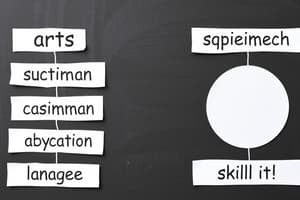Podcast
Questions and Answers
Which of the following is an example of a collective noun?
Which of the following is an example of a collective noun?
- Herd (correct)
- Friendship
- Book
- City
Which sentence is an example of a compound-complex sentence?
Which sentence is an example of a compound-complex sentence?
- The dog barks.
- The cat sleeps when it is tired, and the dog barks loudly. (correct)
- Although it was raining, we went outside.
- I read a book.
What type of verb is 'am' in the sentence 'I am happy'?
What type of verb is 'am' in the sentence 'I am happy'?
- Action
- Auxiliary
- Transitive
- Linking (correct)
Which of the following words is an example of a demonstrative pronoun?
Which of the following words is an example of a demonstrative pronoun?
Identify the adverb in the following sentence: 'She sings beautifully every morning.'
Identify the adverb in the following sentence: 'She sings beautifully every morning.'
Which term correctly defines words that connect clauses or sentences?
Which term correctly defines words that connect clauses or sentences?
What type of sentence is: 'When it rains, the grass grows and the flowers bloom'?
What type of sentence is: 'When it rains, the grass grows and the flowers bloom'?
Which of the following is not a type of adjective?
Which of the following is not a type of adjective?
Which sentence exemplifies the perfect continuous tense?
Which sentence exemplifies the perfect continuous tense?
What is the primary use of a semicolon?
What is the primary use of a semicolon?
Which of the following sentences demonstrates active voice?
Which of the following sentences demonstrates active voice?
Select the sentence that uses a comma correctly.
Select the sentence that uses a comma correctly.
Identify the incorrect subject-verb agreement.
Identify the incorrect subject-verb agreement.
Which punctuation mark is used to end an interrogative sentence?
Which punctuation mark is used to end an interrogative sentence?
Flashcards are hidden until you start studying
Study Notes
Parts of Speech
-
Nouns
- Definition: Words that name people, places, things, or ideas.
- Types: Common, proper, abstract, collective.
-
Pronouns
- Definition: Words that replace nouns.
- Types: Personal, possessive, reflexive, relative, demonstrative, interrogative.
-
Verbs
- Definition: Words that express action or state of being.
- Types: Action (transitive and intransitive), linking, auxiliary.
-
Adjectives
- Definition: Words that describe or modify nouns.
- Types: Descriptive, quantitative, demonstrative, possessive, interrogative.
-
Adverbs
- Definition: Words that modify verbs, adjectives, or other adverbs.
- Types: Manner, time, place, frequency, degree.
-
Prepositions
- Definition: Words that show relationships between nouns (or pronouns) and other words in a sentence.
- Examples: in, on, at, between, under, over.
-
Conjunctions
- Definition: Words that connect clauses, sentences, or words.
- Types: Coordinating (for, and, nor, but, or, yet, so), subordinating (although, because, since), correlative (either/or, neither/nor).
-
Interjections
- Definition: Words that express strong emotion or surprise.
- Examples: Oh!, Wow!, Ouch!, Hooray!
Sentence Structure
-
Simple Sentences
- Contains one independent clause.
- Example: The cat sleeps.
-
Compound Sentences
- Contains two or more independent clauses joined by a coordinating conjunction.
- Example: The cat sleeps, and the dog barks.
-
Complex Sentences
- Contains one independent clause and at least one dependent clause.
- Example: The cat sleeps when it is tired.
-
Compound-Complex Sentences
- Contains at least two independent clauses and one or more dependent clauses.
- Example: The cat sleeps when it is tired, and the dog barks loudly.
Tenses
-
Present
- Simple: I walk.
- Continuous: I am walking.
- Perfect: I have walked.
- Perfect Continuous: I have been walking.
-
Past
- Simple: I walked.
- Continuous: I was walking.
- Perfect: I had walked.
- Perfect Continuous: I had been walking.
-
Future
- Simple: I will walk.
- Continuous: I will be walking.
- Perfect: I will have walked.
- Perfect Continuous: I will have been walking.
Punctuation
-
Periods (.)
- Used to end declarative sentences.
-
Commas (,)
- Used to separate items in a list, join independent clauses, and set off non-essential information.
-
Question Marks (?)
- Used at the end of interrogative sentences.
-
Exclamation Points (!)
- Used to express strong emotion.
-
Colons (:)
- Used to introduce lists or explanations.
-
Semicolons (;)
- Used to connect closely related independent clauses.
Subject-Verb Agreement
- Subjects and verbs must agree in number (singular/plural).
- Example: She runs (singular) vs. They run (plural).
Active and Passive Voice
-
Active Voice
- The subject performs the action.
- Example: The chef cooked the meal.
-
Passive Voice
- The subject receives the action.
- Example: The meal was cooked by the chef.
Parts of Speech
- Nouns: Name entities like people, places, things, or ideas. Types include common, proper, abstract, and collective.
- Pronouns: Replace nouns to avoid repetition. Types consist of personal, possessive, reflexive, relative, demonstrative, and interrogative.
- Verbs: Express actions or states of being. Types are action verbs (transitive or intransitive), linking verbs, and auxiliary verbs.
- Adjectives: Describe or modify nouns, categorized as descriptive, quantitative, demonstrative, possessive, or interrogative.
- Adverbs: Modify verbs, adjectives, or other adverbs. Types include manner, time, place, frequency, and degree.
- Prepositions: Show relationships between nouns (or pronouns) and other sentence elements. Examples include in, on, at, between, under, and over.
- Conjunctions: Connect clauses, sentences, or words. Types are coordinating (for, and, nor, but, or, yet, so), subordinating (although, because, since), and correlative (either/or, neither/nor).
- Interjections: Express strong emotion or surprise. Examples are Oh!, Wow!, Ouch!, and Hooray!
Sentence Structure
- Simple Sentences: Contain one independent clause. Example: "The cat sleeps."
- Compound Sentences: Include two or more independent clauses joined by a coordinating conjunction. Example: "The cat sleeps, and the dog barks."
- Complex Sentences: Feature one independent clause and at least one dependent clause. Example: "The cat sleeps when it is tired."
- Compound-Complex Sentences: Have at least two independent clauses and one or more dependent clauses. Example: "The cat sleeps when it is tired, and the dog barks loudly."
Tenses
- Present Tense:
- Simple: "I walk."
- Continuous: "I am walking."
- Perfect: "I have walked."
- Perfect Continuous: "I have been walking."
- Past Tense:
- Simple: "I walked."
- Continuous: "I was walking."
- Perfect: "I had walked."
- Perfect Continuous: "I had been walking."
- Future Tense:
- Simple: "I will walk."
- Continuous: "I will be walking."
- Perfect: "I will have walked."
- Perfect Continuous: "I will have been walking."
Punctuation
- Periods (.): Indicate the end of declarative sentences.
- Commas (,): Separate items in a list, join independent clauses, and set off non-essential information.
- Question Marks (?): Used to end interrogative sentences.
- Exclamation Points (!): Express strong emotions.
- Colons (:): Introduce lists or explanations.
- Semicolons (;): Connect closely related independent clauses.
Subject-Verb Agreement
- Subjects and verbs must agree in number, whether singular or plural. Example: "She runs" (singular) vs. "They run" (plural).
Active and Passive Voice
- Active Voice: The subject performs the action. Example: "The chef cooked the meal."
- Passive Voice: The subject receives the action. Example: "The meal was cooked by the chef."
Studying That Suits You
Use AI to generate personalized quizzes and flashcards to suit your learning preferences.




